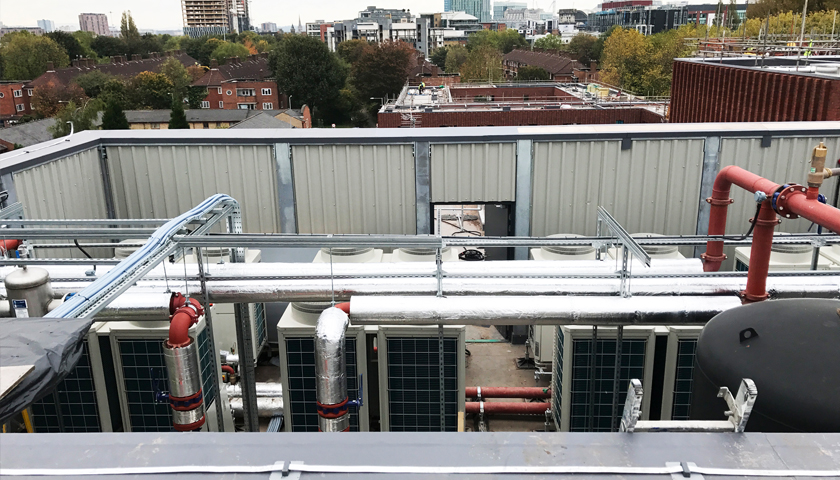When you consider that we are building less than 1% of our housing stock each year – as TV presenter George Clarke reports in his latest piece on The Hub, it is clear that we cannot simply ‘build’ our way to a sustainable future.
The nation needs to be 80% cleaner by 2050 in terms of carbon reduction but about 80% of our current buildings will still be in use by 2050, so this is a massive issue that we all need to tackle.
We therefore have to find a way of making existing buildings carbon-free and renewable heating is a major part of achieving that. Which brings me back to the new Manchester development that I started with.
The development uses 8 commercial Ecodan air source heat pumps as a community heating system to provide heating and hot water to 105 apartments. This has helped the developers meet environmental planning requirements by achieving strict carbon reduction targets (more than 35% above Standard Assessment Procedure) to gain planning permission.
Take a leaf out of this story
The Aaben is a modern development of 105 homes, all available for market rent, on Leaf Street in Hulme. Located just south of Manchester’s city centre, Hulme boasts a creative art scene, independent restaurants and cafes and a thriving local community.
The development itself is named after an old building dating back to the 1920s which was situated close by until it was knocked down in 1993. For decades before it had served as a community cinema and, for a short time, a bingo hall.
The new Aaben is a mixture of 1, 2 and 3-bedroom apartments set around communal, external space, and 3-bedroom town houses with private gardens. Many of the living rooms benefit from direct sunlight and a shared public garden sits at the centre of the development for the wider community to enjoy.
Designed with quality, comfort and energy efficiency in mind, the homes include a range of features that will benefit the environment and reduce residents’ energy bills.
Cost savings
The original design was based on a ground source heat pump (GSHP) but the cost proved beyond the required budget, so design consultant Engineering Design Partnership (EDP) was tasked with value engineering the scheme.
This led to Mitsubishi Electric’s involvement, as Dan Martell, Design Engineer at EDP, explained: “Following the successful installation of a Mitsubishi Electric air source heat pump (ASHP) system on a previous residential scheme we recommended the Ecodan ASHP system as we felt it would be a well performing, cost-efficient solution ideal for The Aaben.”
The Aaben was completed in the autumn of 2017 and thanks to the Ecodan system is eligible to benefit from the non-domestic Renewable Heat Incentive (RHI).
Building work began in November 2016 and Proline Mechanical was the installation company assigned to the project. Proline is one of the UK’s leading building services engineering and maintenance contractors specialising in detailed revit design, thermal dynamic modelling, BIM, engineering installation and commissioning of mechanical and electrical services.
Proline installed a multiple unit Ecodan system on the main roof of the development. Consisting of 8 x CAHV-P500YA units, the community heating system provides hot water to a heat interface unit located within each dwelling for hot water and heating within that dwelling. Each tenant is charged accordingly via a heat meter measuring how much heat energy is taken from the network.
Proline’s Project Manager, Paul Gledhill, said: “The Ecodan system was perfect for this project as the ASHP units are designed to meet the heating and domestic hot water (DHW) requirements for all dwellings via a district heating system. As the system is located on the main roof very near to dwellings there were some sound issues to overcome but these were easily resolved with the erection of an acoustic wall to prevent sound breaching the plant area.”
The ASHP system boasts a capacity of 344KW and can operate at sufficiently high temperature to provide heating and DHW. These systems can also guarantee performance down to -10°C and will happily continue working down to -20°C.
A modular approach to the community
The industry has already looked at community heating in a variety of forms and one of the occasional issues that arise relate to individual control and bills, and what happens if the entire system fails – does everyone lose their heating?
Well that is where a community heating scheme based on modular heat pumps working together can have further benefits.
Not only does the system allow each apartment to control their own heating and hot water requirements, working out exactly how much energy each property is consuming, because the community heating uses a number of heat pumps – in this case 8, if there is an issue with one, or when it needs to go offline for annual maintenance, then the other units on the system pick up the slack and ensure that everyone still keeps receiving heating.
The system also utilises a 6,000 litre buffer tank to store thermal energy for short peak demands and although this particular project is a new-build, there is no reason why the technology cannot be applied on a wider scale, to a huge variety of different projects.


